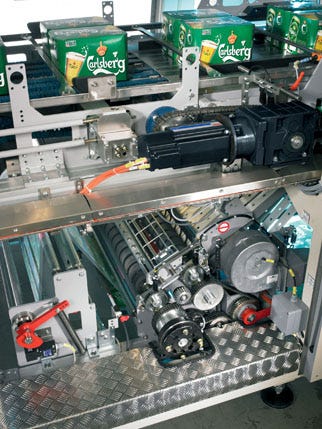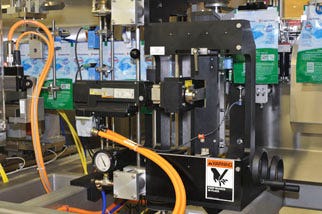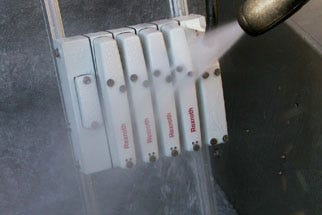Sustainable Automation for Packaging: Reducing Total Cost of Ownership
Total Cost of Ownership (TCO) is a fundamental tool for business capital planning. It analyzes the purchase price of a capital input -- a computer system, a building, or any production machinery -- as well as the total expenses 
TCO 1.jpg
incurred over a machine's lifetime, so you can make the most economical choices, based on the investment's ability to cover its cost and generate the return desired.
TCO allows you to look at the cost for operations and maintenance in addition to original acquisition cost. And it helps you compare the costs of different types of equipment or systems under consideration, and choose the one most likely to be least costly over time.
For food and packaging operations, it is a critical tool for guiding decisions about your automation investments. And in an era when sustainable manufacturing and sustainable packaging plays such an important role in the industry's fundamental strategies, TCO can equip you with the information you need to make machine investments that are both financially and environmentally rewarding.
We find that decisions based on TCO may lead to lifetime cost reductions of as much as 30% in factory automation applications. Most of the cost reductions come from reducing operational costs in two ways:
��• Utilizing more energy-efficient technology, thereby reducing energy consumption;
•Reducing maintenance costs and material waste by selecting components that are longer-lasting, more durable and do not require repeated repairs or replacement parts.
These reductions not only reduce costs; they also increase sustainable manufacturing through greater energy efficiency and less waste.
Rexroth 4EE: One key to sustainable automation
To help machine builders and manufacturers achieve the highest level of energy efficiency over the total life of their automation systems, Rexroth 4EE (Rexroth for Energy Efficiency) defines four key areas or "levers" where the right engineering concepts and systems, effectively applied, can leverage multiple improvements:
Energy efficient components with optimal efficiency reduce energy consumption with every motion. 
TCO 3.jpg
They form the basis for economical mechatronic system solutions.
Energy recovery stores excess energy generated during braking. Depending on the application and general conditions, storage-charging circuits and regenerative supply devices utilize this energy to supply it to other consumers in the system, and store it in a buffer for the next cycle or feed it into the electricity supply grid.
Energy on demand calls up only the amount of energy that is currently needed. This demand-controlled energy use utilizes intelligent control strategies that consider the respective characteristics of the drive technologies.
Energy system design consists of the systemic overall view from analysis via simulation, project planning and consultation up to optimization of process flows using intelligent controls.
Across the full range of components and systems we provide, including electric drives, motors, control platforms, linear motion components and conveyors, and pneumatic and hydraulic motion and control systems, Rexroth 4EE provides a foundation for machine concepts that can be designed and operated with the highest levels of both sustainable energy efficiency and cost-effective productivity -- two of the most important components of TCO analysis and decision-making.
Guidelines for choosing automation energy media
Manufacturing requires motion -- and that requires energy. Today's state-of-the-art automation platforms have a variety of technologies that can be used to drive machine operations. The three most common are hydraulic, electro-mechanical and pneumatic. As a supplier of all three of these technologies, Rexroth has developed a comparison to aid in identifying the best fit for a given application.
Hydraulic ElectroMechanical Pneumatic
Transmission limited and very slow very fast and unlimited limited and slow
Economical distance to approx. 100m practically unlimited to approx. 1000m
Transmission speed approx. 2-6 m/s approx. 300,000 km/s approx. 10-50 m/s
Storage limited possibility difficult simple
Energy costs high low very high
Generation of linear motion very simple intricate and costly very simple
Working speed to approx. 0.5 m/s to approx. 10 m/st to approx. 4 m/s
Power density very high low low
Achievable force very high high limited, approx. 20 kN
Achievable stroke high, to 10 m and more high limited, approx. 2 m
Change of forces simple and accurate complex simple
Speeds simple and accurate complex simple
Efficiency good average poor
Connections complex simple very simple
Overload safety complete complex complete
Innately explosion proof partial no yes
In a TCO analysis, choosing the right energy media is governed by multiple operational factors, which will affect costs, both initially and over a machine's lifetime. In the chart above, we provide an objective comparison of these factors, to enable a more effective TCO analysis.
Matching the right drive technology to an application's performance requirements -- whether it's a specific machine axis, a packaging subsystem such as a conveyor or a complete solution -- will pay off in dramatic energy efficiencies.
Avoid paying 50% more than planned
Consumer shopping provides a number of easy-to-understand examples, because our personal pocketbooks are affected when we realize that some of the products we buy cost a lot more than the initial price. When, for example, we pay $25,000 for a car, we know that operating and maintenance costs are soon to follow. Over a 5-year period, these expenses can easily add up to $12,000, about 50% of the price of the vehicle. It's easy to forget additional costs, such as insurance premiums, which vary from car to car and region to region, or even optional items that might be good ideas, such as snow tires.
Similar logic applies in the purchase of capital equipment: It's easy to add unexpected costs to the ownership experience, both before and after the purchase, if you look only at the initial purchase price. The "cheap" solution in the short term may end up costing you more in the long run. Let's look at the different phases of engineering, and the sometimes unexpected costs that lurk there.
Planning: The pre-purchase phase
This is the most important phase when implementing factory automation. In this phase, the cost elements influencing TCO depend on the time required to design, specify, and purchase the appropriate system. Making good choices in the pre-purchase phase can save time in designing the system and in sourcing the components.
It is important to consider how to minimize the operational and maintenance costs in this phase; selection of the most durable and energy efficient technology will significantly impact TCO. An example for this is selecting de-centralized factory automation technology like wash-down rated pneumatics valve manifolds and integrated electric drives & motors that can both contribute to reduced control cabinet, installation cost and energy consumption.
Operation: The post-purchase phase
After the system is put into service, maintenance work can add thousands of dollars to the cost of ownership over the life of the system. This is a key area 
TCO 5 - Washdown.jpg
often underestimated by design engineers. Some linear products, for example, are marketed as "lubed for life." However, it is important to note that the life (number of meters or revolutions traveled) is often defined with no load applied to the system.
But when a load of just 100 lb. is applied, the life of these components can be sharply reduced, for example, from 25,000 km to 5,000 km. For a machine with 1-m stroke, traveling at 1 m/s for 16 hours per day, this equates to approximately one full year of life lost, increasing replacement frequency by 33%.
Another area that should be considered is systems and components that are easily maintained and repaired when needed. This will not only help reduce the maintenance cost but also significantly reduce TCO by minimizing equipment downtime.
Use TCO to get a more complete portrait of the operational and environmental costs of your packaging machinery investments -- before you make that investment. Making the right choice, based on these criteria, will not only help reduce expenditures for energy, replacement components and other operational materials over time; it will enable you to create a more sustainable and environmentally friendly manufacturing platform that delivers the value your business needs to be profitable and competitive in today's global packaging and consumer goods markets.
TCO Checklist
Reducing acquisition costs
Utilizing interactive design tools
Functional integration/ systems
Solutions that affect installation and structural costs
Consolidation of vendors and part-numbers
Considerations for necessary investments in plant competence
Reducing maintenance costs
Evaluating/selecting durable components
Use of interchangeability standards, open protocols, etc.
Design includes predictive maintenance/ diagnostics
Solutions for extended life in washdown applications
Reducing operational (energy) costs
Reduced air consumption with optimized pneumatic
Minimizing friction for mechanical components
Regeneration and sharing of energy in electrical drives
Integrated servo drives & motors to eliminate cabinet cooling
Selecting energy efficient electrical motors
Written by Kjell Lyngstad, Global Account Manager, Bosch Rexroth
About the Author(s)
You May Also Like


